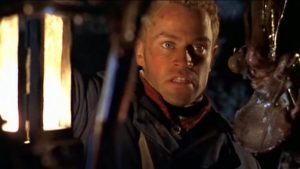𝙍𝙖𝙫𝙚𝙣𝙤𝙪𝙨 (𝟭𝟵𝟵𝟵)

Ravenous (1999) – Comprehensive Overview
🍽️🧟♂️🔪🌲
Overview
Ravenous (1999) is a critically acclaimed horror film directed by Antonia Bird and written by John Gilroy. The film is renowned for its unique blend of horror, dark comedy, and social commentary, set against the backdrop of 19th-century California. Starring Guy Pearce, Peter Fonda, Jeffrey Jones, and Robert Carlyle, Ravenous explores themes of cannibalism, greed, and the corrupting influence of power.
Plot Summary
Set during the Mexican-American War in 1849, Ravenous follows Seth Brundle (Guy Pearce), a young medical student who joins a remote military outpost in the Sierra Nevada mountains. The isolated post is commanded by the enigmatic and morally ambiguous Captain John Marsh (Peter Fonda). As the harsh winter sets in, tensions rise among the soldiers, and mysterious deaths begin to occur.
The arrival of Brundle brings a fresh perspective, but he soon discovers that Marsh harbors dark secrets. It becomes apparent that Marsh is engaged in acts of cannibalism, justifying his actions as a means of survival and asserting dominance. As the body count increases, Brundle must confront Marsh’s monstrous behavior and navigate the treacherous dynamics of the isolated outpost.
The film reaches its climax when Brundle, driven by a combination of horror and a desire for justice, takes a stand against Marsh. The confrontation culminates in a brutal and symbolic battle, highlighting the thin line between civilization and savagery.
Characters and Performances
- Seth Brundle (Guy Pearce):
Pearce delivers a compelling performance as Brundle, portraying him as both compassionate and resolute. His character’s transformation from an idealistic medical student to a hardened survivor adds depth to the narrative. - Captain John Marsh (Peter Fonda):
Fonda embodies the role of Marsh with chilling authority and charisma. His portrayal of Marsh’s descent into madness and cannibalism is both terrifying and tragic, making him one of the film’s standout characters. - Mr. Scudder (Jeffrey Jones):
Jones plays the morally conflicted surgeon who struggles with Marsh’s actions. His performance adds a layer of internal conflict and ethical dilemma to the story. - Private Hughie MacMillan (Robert Carlyle):
Carlyle portrays MacMillan with intensity and unpredictability, serving as a wildcard within the outpost’s dynamics. His character’s volatility contributes to the mounting tension.
Themes and Direction
- Cannibalism and Survival:
At its core, Ravenous examines the extremes of human behavior under duress. The film delves into the moral ambiguities of cannibalism, questioning what one is willing to do to survive. - Corruption of Power:
Captain Marsh’s abuse of power highlights how authority can lead to moral decay. The film critiques the unchecked power structures within military settings and their potential for fostering corruption. - Isolation and Madness:
The remote setting amplifies the characters’ psychological struggles, exploring how isolation can push individuals to the brink of sanity and humanity.
Antonia Bird’s direction masterfully balances horror elements with dark humor and poignant social commentary. Her ability to create a claustrophobic and eerie atmosphere keeps audiences on edge while encouraging them to ponder deeper ethical questions.
Visuals and Cinematography
Cinematographer Sean Bobbitt employs a stark and desaturated color palette, emphasizing the bleak and unforgiving environment of the Sierra Nevada. The use of natural lighting and expansive landscapes contrasts sharply with the intimate and gruesome scenes of cannibalism, enhancing the film’s visual impact.
The film’s practical effects, particularly in depicting the horrific acts of cannibalism, are both realistic and unsettling. The seamless integration of these effects with the natural setting creates a disturbing juxtaposition that heightens the overall horror experience.
Music and Soundtrack
The score, composed by Michael Kamen, complements the film’s tense and foreboding atmosphere. Kamen’s orchestral compositions underscore the mounting tension and emotional turmoil, enhancing key moments of confrontation and despair.
Sound design plays a crucial role in Ravenous, with ambient noises and haunting soundscapes contributing to the film’s unsettling mood. The minimalistic use of music in certain scenes allows the natural sounds of the wilderness and the characters’ actions to take center stage, adding to the realism and immersion.
Critical Reception
Upon its release, Ravenous received widespread acclaim for its innovative approach to the horror genre and its thought-provoking themes. Critics praised the film for its strong performances, particularly those of Guy Pearce and Peter Fonda, as well as Antonia Bird’s adept direction.
- Rotten Tomatoes:
Ravenous holds an approval rating of approximately 80%, with critics lauding its unique storytelling and atmospheric tension. - Metacritic:
The film has a weighted average score of 72, indicating generally favorable reviews.
Audiences appreciated the film’s ability to blend horror with dark comedy and social commentary, making it a standout entry in late 1990s cinema.
Box Office and Cultural Impact
Ravenous achieved moderate box office success, grossing over $35 million worldwide against a budget of approximately $30 million. While it may not have been a blockbuster hit, the film has since gained a cult following for its bold narrative and memorable performances.
Cultural Impact:
- Influence on Horror Genre:
Ravenous is often cited for its unique take on cannibalism and its integration of dark humor, influencing subsequent horror films that seek to explore similar themes with a blend of genres. - Representation of Moral Ambiguity:
The film’s exploration of ethical dilemmas and the human capacity for darkness has resonated with audiences and critics, sparking discussions about morality in extreme situations. - Peter Fonda’s Iconic Role:
Marsh’s character is considered one of Fonda’s most memorable roles, showcasing his versatility and ability to portray complex antagonists.
Conclusion
Ravenous (1999) stands as a distinctive and thought-provoking film within the horror genre, offering a compelling narrative that challenges viewers to confront uncomfortable ethical questions. With standout performances, masterful direction, and a haunting atmosphere, the film continues to be celebrated for its bold storytelling and lasting impact on both audiences and the genre at large.
Whether you’re a horror aficionado intrigued by psychological and moral complexities or a casual viewer seeking a gripping and unique cinematic experience, Ravenous delivers a memorable and unsettling journey into the darkest corners of human nature.











